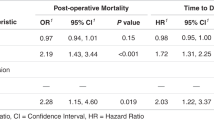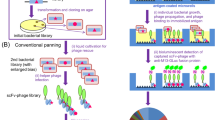Abstract
Despite the dismal prognosis for patients with squamous cell carcinoma of the head and neck (SCCHN), there have been no novel treatments in over 40 years. Identification of novel tumor antigens in SCCHN will facilitate the identification of potential novel treatment targets. Tumor antigens are proteins selectively expressed by tumor cells and recognized by the host immune system. Phage-displayed tumor antigens were enriched by biopanning with normal and then SCCHN-specific serum. Ninety-six phage clones were sequenced for identification, and 21 clones were validated using Luminex. One of these proteins, L23, a novel tumor antigen in SCCHN, was validated as an oncogene. L23 is upregulated in SCCHN compared with normal keratinocytes. Knockdown of L23 inhibited proliferation, invasion and cell survival. Overexpression of L23 had the reverse effect. Overexpression of L23 in non malignant cells led to transformation. Injection of SCCHN cells with knockdown of L23 in mice, induced tumors that were significantly smaller than control tumors. In conclusion, the immunomic screen yielded a panel of antigens specific to SCCHN; one of these proteins, L23, is a novel oncogene in SCCHN.
This is a preview of subscription content, access via your institution
Access options
Subscribe to this journal
Receive 50 print issues and online access
$259.00 per year
only $5.18 per issue
Buy this article
- Purchase on Springer Link
- Instant access to full article PDF
Prices may be subject to local taxes which are calculated during checkout







Similar content being viewed by others
References
Leemans CR, Braakhuis BJ, Brakenhoff RH . The molecular biology of head and neck cancer. Nat Rev Cancer 2011; 11: 9–22.
Jemal A, Siegel R, Xu J, Ward E . Cancer statistics, 2010. CA Cancer J Clin 2010; 60: 277–300.
Siegel R, Ward E, Brawley O, Jemal A . Cancer statistics, 2011: the impact of eliminating socioeconomic and racial disparities on premature cancer deaths. CA Cancer J Clin 2011; 61: 212–236.
Li G, Ali SA, McArdle SE, Mian S, Ahmad M, Miles A et al. Immunity to tumour antigens. Curr Pharm Des 2005; 11: 3501–3509.
Laheru DA, Pardoll DM, Jaffee EM . Genes to vaccines for immunotherapy: how the molecular biology revolution has influenced cancer immunology. Mol Cancer Ther 2005; 4: 1645–1652.
Sahin U, Türeci O, Schmitt H, Cochlovius B, Johannes T, Schmits R et al. Human neoplasms elicit multiple specific immune responses in the autologous host. Proc Natl Acad Sci USA 1995; 92: 11810–11813.
Chen YT, Güre AO, Tsang S, Stockert E, Jäger E, Knuth A et al. Identification of multiple cancer/testis antigens by allogeneic antibody screening of a melanoma cell line library. Proc Natl Acad Sci USA 1998; 95: 6919–6923.
Chen YT, Scanlan MJ, Sahin U, Türeci O, Gure AO, Tsang S et al. A testicular antigen aberrantly expressed in human cancers detected by autologous antibody screening. Proc Natl Acad Sci USA 1997; 94: 1914–1918.
Stockert E, Stockert E, Jäger E, Chen YT, Scanlan MJ, Gout I et al. A survey of the humoral immune response of cancer patients to a panel of human tumor antigens. J Exp Med 1998; 187: 1349–1354.
Scott JK, Smith GP . Searching for peptide ligands with an epitope library. Science 1990; 249: 386–390.
Wang X, Yu J, Sreekumar A, Varambally S, Shen R, Giacherio D et al. Autoantibody signatures in prostate cancer. N Engl J Med 2005; 353: 1224–1235.
Griffiths AD, Malmqvist M, Marks JD, Bye JM, Embleton MJ, McCafferty J et al. Human anti-self antibodies with high specificity from phage display libraries. Embo J 1993; 12: 725–734.
Bonnycastle LL, Mehroke JS, Rashed M, Gong X, Scott JK . Probing the basis of antibody reactivity with a panel of constrained peptide libraries displayed by filamentous phage. J Mol Biol 1996; 258: 747–762.
Wanzel M, Wanzel M, Russ AC, Kleine-Kohlbrecher D, Colombo E, Pelicci PG et al. A ribosomal protein L23-nucleophosmin circuit coordinates Mizl function with cell growth. Nat Cell Biol 2008; 10: 1051–1061.
Liu F, Li Y, Yu Y, Fu S, Li P . Cloning of novel tumor metastasis-related genes from the highly metastatic human lung adenocarcinoma cell line Anip973. J Genet Genomics 2007; 34: 189–195.
Shi Y, Zhai H, Wang X, Han Z, Liu C, Lan M et al. Ribosomal proteins S13 and L23 promote multidrug resistance in gastric cancer cells by suppressing drug-induced apoptosis. Exp Cell Res 2004; 296: 337–346.
Bigler LR, Streckfus CF, Copeland L, Burns R, Dai X, Kuhn M et al. The potential use of saliva to detect recurrence of disease in women with breast carcinoma. J Oral Pathol Med 2002; 31: 421–31.
Leethanakul C, Patel V, Gillespie J, Shillitoe E, Kellman RM, Ensley JF et al. Gene expression profiles in squamous cell carcinomas of the oral cavity: use of laser capture microdissection for the construction and analysis of stage-specific cDNA libraries. Oral Oncol 2000; 36: 474–483.
Dybwad A, Førre O, Kjeldsen-Kragh J, Natvig JB, Sioud M . Identification of new B cell epitopes in the sera of rheumatoid arthritis patients using a random nanopeptide phage library. Eur J Immunol 1993; 23: 3189–3193.
Zhang Y, Lu H . Signaling to p53: ribosomal proteins find their way. Cancer Cell 2009; 16: 369–377.
Dai MS, Lu H . Inhibition of MDM2-mediated p53 ubiquitination and degradation by ribosomal protein L5. J Biol Chem 2004; 279: 44475–44482.
Dai MS, Zeng SX, Jin Y, Sun XX, David L, Lu H . Ribosomal protein L23 activates p53 by inhibiting MDM2 function in response to ribosomal perturbation but not to translation inhibition. Mol Cell Biol 2004; 24: 7654–7668.
Dai MS, Shi D, Jin Y, Sun XX, Zhang Y, Grossman SR et al. Regulation of the MDM2-p53 pathway by ribosomal protein L11 involves a post-ubiquitination mechanism. J Biol Chem 2006; 281: 24304–24313.
Jin A, Itahana K, O’Keefe K, Zhang Y . Inhibition of HDM2 and activation of p53 by ribosomal protein L23. Mol Cell Biol 2004; 24: 7669–7680.
Stransky N, Egloff AM, Tward AD, Kostic AD, Cibulskis K, Sivachenko A et al. The mutational landscape of head and neck squamous cell carcinoma. Science 2011; 333: 1157–1160.
Agrawal N, Frederick MJ, Pickering CR, Bettegowda C, Chang K, Li RJ et al. Exome sequencing of head and neck squamous cell carcinoma reveals inactivating mutations in NOTCH1. Science 2011; 333: 1154–1157.
Brakenhoff RH . Cancer. Another NOTCH for cancer. Science 2011; 333: 1102–1103.
Patel V, Hood BL, Molinolo AA, Lee NH, Conrads TP, Braisted JC et al. Proteomic analysis of laser-captured paraffin-embedded tissues: a molecular portrait of head and neck cancer progression. Clin Cancer Res 2008; 14: 1002–1014.
Philip M, Schietinger A, Schreiber H . Ribosomal versus non-ribosomal cellular antigens: factors determining efficiency of indirect presentation to CD4+ T cells. Immunology 2010; 130: 494–503.
Monach PA, Meredith SC, Siegel CT, Schreiber H . A unique tumor antigen produced by a single amino acid substitution. Immunity 1995; 2: 45–59.
Matsutake T, Srivastava PK . The immunoprotective MHC II epitope of a chemically induced tumor harbors a unique mutation in a ribosomal protein. Proc Natl Acad Sci USA 2001; 98: 3992–3997.
Beck-Engeser GB, Monach PA, Mumberg D, Yang F, Wanderling S, Schreiber K et al. Point mutation in essential genes with loss or mutation of the second allele: relevance to the retention of tumor-specific antigens. J Exp Med 2001; 194: 285–300.
Koga M, Shichijo S, Yamada A, Ashihara J, Sawamizu H, Kusukawa J et al. Identification of ribosomal proteins S2 and L10a as tumor antigens recognized by HLA-A26-restricted CTL. Tissue Antigen 2003; 61: 136–145.
Ferris RL, Jaffee EM, Ferrone S . Tumor antigen-targeted, monoclonal antibody-based immunotherapy: clinical response, cellular immunity, and immunoescape. J Clin Oncol 2010; 28: 4390–4399.
Bsoul SA, Huber MA, Terezhalmy GT . Squamous cell carcinoma of the oral tissues: a comprehensive review for oral healthcare providers. J Contemp Dent Pract 2005; 6: 1–16.
Neville BW et al. Oral and Maxillofacial Pathology. 2nd edn (WB Saunders, 2002, 337–367).
Nemeth Z, Velich N, Bogdan S, Ujpál M, Szabó G, Suba ZS . The prognostic role of clinical, morphological and molecular markers in oral squamous cell tumors. Neoplasma 2005; 52: 95–102.
Chen G, Wang X, Yu J, Varambally S, Yu J, Thomas DG et al. Autoantibody profiles reveal ubiquilin 1 as a humoral immune response target in lung adenocarcinoma. Cancer Res 2007; 67: 3461–3467.
Banerjee R, Mani RS, Russo N, Scanlon CS, Tsodikov A, Jing X et al. The tumor suppressor gene rap1GAP is silenced by miR-101-mediated EZH2 overexpression in invasive squamous cell carcinoma. Oncogene 2011; 30: 4339–4349.
Goto M, Mitra RS, Liu M, Lee J, Henson BS, Carey T et al. Rap1 stabilizes beta-catenin and enhances beta-catenin-dependent transcription and invasion in squamous cell carcinoma of the head and neck. Clin Cancer Res 2010; 16: 65–76.
Mitra RS, Zhang Z, Henson BS, Kurnit DM, Carey TE, D’Silva NJ . Rap1A and rap1B ras-family proteins are prominently expressed in the nucleus of squamous carcinomas: nuclear translocation of GTP-bound active form. Oncogene 2003; 22: 6243–6256.
Mitra RS, Goto M, Lee JS, Maldonado D, Taylor JM, Pan Q et al. Rap1GAP promotes invasion via induction of matrix metalloproteinase 9 secretion, which is associated with poor survival in low N-stage squamous cell carcinoma. Cancer Res 2008; 68: 3959–3969.
Zhang Z, Mitra RS, Henson BS, Datta NS, McCauley LK, Kumar P et al. Rap1GAP inhibits tumor growth in oropharyngeal squamous cell carcinoma. Am J Pathol 2006; 168: 585–596.
Acknowledgements
The authors would like to thank Kenneth Rieger for his artistic assistance with illustrations. This work was supported by NIDCR DE017977, DE019513, MICHR CTSA UL1RR024986, Research Development award from NCI SPORE grant P50 CA97248 (NJD). This research was made possible, in part, by the use of the Cancer Center Flow Cytometry Core which was supported (in part) by the National Institutes of Health through the University of Michigan’s Cancer Center Support Grant (5 P30 CA46592).
Author information
Authors and Affiliations
Corresponding author
Ethics declarations
Competing interests
Dr Chinnaiyan is a co-founder of Compendia Biosciences, which supports the Oncomine database used in this study. Compendia Biosciences is a wholly owned subsidiary of Life Technologies, in which Dr Chinnaiyan serves on the Medical Advisory Board. Life Technologies and/or Compendia Biosciences did not play a role in the design and conduct of this study, in the collection, analysis or interpretation of the data, or in the preparation, review or approval of the article.
Rights and permissions
About this article
Cite this article
Russo, N., Wang, X., Liu, M. et al. A novel approach to biomarker discovery in head and neck cancer using an autoantibody signature. Oncogene 32, 5026–5037 (2013). https://doi.org/10.1038/onc.2012.532
Received:
Revised:
Accepted:
Published:
Issue Date:
DOI: https://doi.org/10.1038/onc.2012.532



